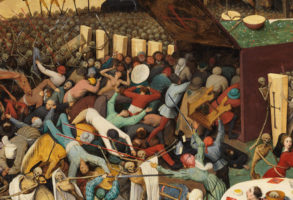Published March 24, 2015
Anticipating the upcoming Supreme Court decision on King v. Burwell, which could halt health insurance subsidies available through the federal exchange, Republican Senators Richard Burr and Orrin Hatch joined with Representative Fred Upton to propose a comprehensive replacement for the Affordable Care Act (ACA). The Patient Choice, Affordability, Responsibility, and Empowerment Act, or Patient CARE Act, is modeled on a proposal of the same name offered last year by Senators Burr, Hatch, and Tom Coburn, who has retired from the Senate. The Burr-Hatch-Upton plan, like its predecessor, adopts consumer-based reforms of the insurance market, modernizes the Medicaid program, and makes other changes intended to lower cost and increase choices.
In an earlier post, we described in detail the provisions of the Burr-Coburn-Hatch bill. In this post, we discuss how the Burr-Hatch-Upton plan differs from the earlier proposal. We also discuss the impact of the new proposal on health insurance coverage, premiums, and the federal budget based on a new analysis from the Center for Health and Economy (H&E), a non-partisan think tank focused on producing informative analyses of trends in U.S. health care policy and reform ideas. We conclude by commenting on the direction Republicans are likely to take in reforming the health system in the aftermath of a Supreme Court decision in the King v. Burwell case.
Major Provisions Of The Burr-Hatch-Upton Plan
The new version of the Patient CARE Act retains the major provisions of last year’s proposal. The plan would repeal the Affordable Care Act and put in its place a series of insurance market reforms intended to widen the range of health plan choices available to consumers. The ACA’s Medicare provisions would not be repealed in the Burr-Hatch-Upton proposal, although the authors make it clear they would pursue alternative Medicare reforms in separate legislation.
Insurance Market Reforms. As with the previous proposal, the Patient CARE Act repeals the ACA’s individual mandate and replaces it with a framework under which no one can be denied coverage or charged higher premiums because of a pre-existing condition as long as they remain continuously enrolled in a health plan. Insurance regulation would be returned to the states, with the presumption that insurers will allow dependents age 26 and younger to enroll in their parent’s coverage. In addition, insurers would be permitted to charge their oldest enrollees no more the five times the premiums assessed to their youngest enrollees, replacing the ACA’s 3:1 rule. States would be free to establish their own insurance regulations that could differ from the federal rules.
Premium Tax Credits. Income-related tax credits would be available to those who do not have access to employer-sponsored health insurance and to workers in small firms with 100 or fewer employees. Individuals with incomes below 200 percent of the federal poverty level would receive a fixed credit. The amount of the credit is higher for older persons, reflecting their greater use of health services. The credit phases out as income increases, and no subsidy is available to individuals with incomes greater than 300 percent of the federal poverty level. The credit amounts would be indexed to the Consumer Price Index (CPI) plus 1 percentage point each year—below the historical growth rate for health premiums—to encourage slower growth in health spending over time.
States would be allowed to design affordable insurance options available through a default enrollment process for individuals who do not take the initiative to choose a plan. Such default options could include a zero-premium plan (with the premium equal to the value of the tax credit). Federal funding would be made available for state high-risk pools to help patients with the most expensive chronic medical conditions.
Medicaid Reform. The Burr-Hatch-Upton proposal would restructure Medicaid in two major ways. First, individuals who are eligible for Medicaid could choose the federal tax credit instead. In states using Medicaid as their default auto-enrollment plan, individuals would retain the right to use the tax credit to purchase private insurance.
Second, federal funding for Medicaid would transition from the current matching rate formula to a capped allotment—known as a health grant—based on each patient’s health status, age, and life circumstances. Health grants would be provided for participants in Medicaid who are neither elderly nor disabled. A separate fixed grant would be provided for long-term care services and supports for low-income elderly and disabled persons who enroll in Medicaid. This modified block grant approach gives states more flexibility to use their resources in the most efficient and effective way in providing for the health needs of their low-income population. The cost of providing acute-care services to the elderly and disabled, who are eligible for both Medicaid and Medicare, would continue to be subsidized through the matching rate formula.
Defensive Medicine. The proposal includes steps to reduce the cost of defensive medicine. States would be given incentives to adopt innovative reforms, such as expert panels or specialized health courts that can quickly and fairly settle malpractice cases. The proposal also adopts measures to increase transparency on cost, quality, and outcomes.
HSAs. In addition, restrictions imposed by the ACA on health savings accounts would be lifted to give patients another way to cover the cost of their care.
How Burr-Hatch-Upton Differs From The Original Version
The Burr-Hatch-Upton version of the Patient CARE Act proposes higher subsidies for the uninsured and changes the way employer-sponsored health insurance is treated in the tax code.
Insurance Subsidies. Tax credit amounts under the current proposal are 26 percent higher than the subsidies suggested last year. With health care inflation hovering around 2.5 percent over the past two years, this represents a large increase in the purchasing power of those subsidies which will translate into increased enrollment in health plans. For example, a 40-year old with an income below 200 percent of the federal poverty level, or $11,770 this year, would receive a tax subsidy of $2,530 under the old proposal and $3,190 under the current one.
Tax Treatment of Employer-Sponsored Coverage. The unlimited exclusion from a worker’s taxes of employer-sponsored insurance has long been criticized for artificially inflating the growth of health care costs. The ACA’s “Cadillac tax” imposes a 40 percent excise tax on the value of health plans exceeding $10,200 for individual coverage and $27,500 for family coverage. Although levied on insurers, the Cadillac tax would be paid by workers and their families through higher premiums and cost sharing and more restricted access to providers. Because it is indexed to general inflation rather than health care inflation, eventually even modest health coverage will be subject to the tax.
The Patient CARE Act proposal replaces the Cadillac tax with a cap on the amount that may be excluded from a worker’s taxes. The original version of the act set the maximum tax exclusion as a fixed percentage of an average plan’s costs, which the bill sponsors suggested would be 65 percent. In their analysis of that proposal, H&A assumed that the upper limit would be $5,400 for single coverage and $11,250 for family coverage (measured in 2013 dollars). Those limits would subsequently be indexed each year to the CPI plus 1 percentage point. In part because the tax exclusion cap was set at a relatively low level, H&E estimated that the Patient CARE Act would increase tax revenue by $1.1 trillion over a decade.
The revised proposal caps the exclusion at $12,000 for individual coverage and $30,000 for family coverage. Because those limits are above the tax thresholds for the ACA’s Cadillac tax, middle-class families with employer-sponsored coverage would fare better under the Burr-Hatch-Upton proposal.
Center On Health And Economy Estimates
H&E recently updated its analysis of the Patient CARE Act to reflect the revised policies in the current plan, as well as refinements to the microsimulation model used to produce the estimates.
H&E’s analysis looks at the proposal’s effects on premiums, insurance coverage status, access to physicians and other providers, productivity of the delivery system, and the federal budget. The baseline against which the proposed changes in policy are assessed is current law. In other words, the changes are measured against the effects that are expected to take place over the coming years as the provisions of the ACA are implemented.
The H&E analysis makes the following key points about the Patient CARE Act:
Reduced Premiums. H&E estimates that the Patient CARE Act would reduce premiums 5 to 17 percent below ACA premium levels in 2025. The reduced premiums are due to the relaxed rules on what is required in the benefit plans, and on the age adjustments allowable for insurance products. H&E estimates that these provisions would allow more products that are attractive to younger and healthier consumers to be sold in the state-regulated markets.
Reduced Insurance Enrollment. The Patient CARE Act would significantly expand insurance enrollment relative to the pre-ACA status quo, but it would fall short of the coverage expansion expected to occur under the ACA. According to H&E, the Patient CARE Act would increase enrollment in the individual insurance market by 8 million people in 2019 relative to the ACA. That increase would be offset by a decline in enrollment in Medicaid of 10 million and a reduction in enrollment in employer-sponsored insurance of 1 million. The net effect would be 3 million more uninsured people in 2019 relative to the ACA. That drop in insurance enrollment would grow slightly in subsequent years.
Access to Care and Service Delivery. H&E finds that the Patient CARE Act would improve access to care relative to the ACA because many more people would be enrolled in open network plans and there would be large migration out of Medicaid and into the individual insurance market. Medicaid provides more restricted access to physician care than private insurance plans, so a shift from Medicaid to private coverage is viewed by H&E as improving access to care. Of course, access under Medicaid is better for those services covered by the program but not traditionally covered by private plans. H&E’s assessment appears to be focused on traditional acute care services and not the services provided in Medicaid that are outside of the typical insurance model.
H&E also believes the overall efficiency of the health system would improve modestly under the Patient CARE Act because there would be higher enrollment in insurance plans with larger deductibles and more cost-sharing. The additional cost-sharing paid by consumers would, in turn, create added market pressure on those delivering services to patients to keep their costs down. Although higher cost-sharing is associated with less intensive use of services, the use of more open networks of providers seems to weigh more heavily in H&E’s access assessments.
The positive cost effects of additional enrollment in higher-deductible health plans would be partially offset by the proposal to scrap the ACA’s Cadillac tax in favor of the upper limit on tax-preferred employer-paid premiums. The limits imposed by the revised Patient CARE Act—$12,000 for individual insurance plans and $30,000 for family coverage in 2017—are above those scheduled to take effect under the Cadillac tax in 2018 — $10,200 for individuals and $27,500 for families. Moreover, the Patient CARE Act limits are indexed to grow more quickly over time than the Cadillac tax — CPI plus 1 percentage point versus CPI. Thus, H&E assumes the Cadillac tax would force employer-sponsored plans to adopt more cost-cutting behavior. This effect is more than offset by the large-scale movement toward high-deductible plans in the individual market under the Patient CARE Act.
Substantial Reduction in Federal Costs but a Net Increase in Future Deficits. H&E estimates that the Patient CARE Act’s coverage provisions would cost $534 billion less than the ACA’s over ten years. The repeal of the ACA’s Medicaid expansion would lower federal spending by $509 billion over a decade. In the first years of implementation of the Patient CARE Act, the cost of the tax credits for coverage in the individual market would exceed that of the ACA’s premium credits, presumably due to the higher participation in the individual insurance market under Burr-Hatch-Upton. By 2025, however, the cost of the tax credits under the Republican proposal would fall below the cost of the ACA’s credits by $28 billion. Over the next decade, subsidies for private insurance (including the premium credits and cost-sharing subsidies) are reduced by $195 billion.
H&E also gives the Patient CARE Act credit for reducing federal costs through medical malpractice reform, saving $61 billion over a decade. The cost reductions of the Burr-Hatch-Upton plan are partially offset by the repeal of the individual and employer mandates, added funding for high-risk pools, and the substitution of a less stringent upper limit on tax-preferred employer coverage for the ACA’s Cadillac tax.
H&E notes that its budget analysis of the Patient CARE Act is incomplete because the proposal also calls for the repeal of the other taxes in the ACA beyond the individual and employer mandates and the Cadillac tax. In July 2012, the Congressional Budget Office (CBO) estimated that repealing these other tax provisions would reduce federal revenues by about $730 billion over a decade. Therefore, the net budgetary effect of all of the Patient CARE Act provisions would be to increase future federal budget deficit modestly, by perhaps $200 billion or so over a decade.
As previously noted, the Patient CARE Act leaves in place the ACA’s Medicare adjustments. However,some Medicare reform plans have the potential to reduce the program’s costs below the levels expected to occur from the ACA’s modifications. Consequently, it is possible that a combination of the Patient CARE Act and separate Medicare reform legislation would result in net deficit reduction compared to the ACA.
A Promising Approach And Some Possible Adjustments
The H&E estimates of the Burr-Hatch-Upton plan make it clear that a well-conceived plan can provide for improved insurance enrollment on a level broadly similar to the ACA, at much less expense to taxpayers and with far less federal control and regulation. Presented properly, this would be appealing to a significant slice of the American electorate.
But it is also clear from these estimates that the Patient CARE Act is a blueprint that will need to be adjusted and refined. Despite modestly adding to future federal deficits, the plan does not cover as many Americans with insurance as the ACA. Moreover, the plan assumes an abrupt switch from the ACA’s Medicaid expansion, premium credits, and cost-sharing assistance to the new system of financial support for health coverage. This is probably unrealistic, as Congress generally prefers to apply new policies prospectively or to provide for a transition period to ease the adjustment to the new rules.
Tightening the Default Enrollment Process. An important feature of the Burr-Hatch-Upton plan is the default enrollment provision, by which states can place persons eligible for the tax credit into insurance plans at no cost to the enrollee. The H&E estimate takes this provision into account but apparently assumes it will not be altogether effective, as there would still be large numbers of uninsured Americans under the plan. One straightforward way to improve the coverage estimates for the Patient CARE Act would be to tighten the default enrollment provision so that it is adopted by all states and used aggressively to boost coverage.
Leveling the Playing Field for Those Inside and Outside Employer-Based Coverage. The Patient CARE Act’s tax credits are income-tested and limited to households below three times the federal poverty line rather than four times the federal poverty line under the ACA. One important consequence of income-tested credits is that households with incomes above the cut-off level and without access to employer coverage get no financial assistance for their premiums. This may be viewed as unfair, given the size of the tax preference for employer coverage and the potentially significant penalty for going uninsured under the Patient CARE Act (in the form of lost protections against risk-rated premiums) that would be burdensome even for households with middle-class incomes but no access to an employer plan. Providing the tax credits to all households outside of the employer system would begin to level the playing field between the individual market and employer coverage. It would also make the proposal much simpler to administer for the U.S. Treasury.
Generating Additional Savings. Of course, adding transition provisions, boosting enrollment through the default enrollment process, and distributing tax credits to the middle class would add to the expense of the Burr-Hatch-Upton plan, and thus further add to future deficits beyond the current H&E estimate. To ensure the proposal reduces the deficit relative to the ACA rather than increases it, additional adjustments are likely to be necessary. Among the options would be lowering the upper limit on tax-preferred employer-paid premiums, achieving more savings through the reform of the Medicaid program, including additional reforms in Medicare and other entitlement programs in the proposal, and other spending cuts.
There Is A Viable Alternative To The ACA
The re-introduction of the Patient CARE Act comes at an important moment in the on-going debate over the direction of health care policy in the United States. The Supreme Court will be issuing a decision in the King v. Burwell case soon, likely in June. If the Court rules in favor of the plaintiffs, it could mean substantial disruption of the insurance markets in the states operating with the federal exchange. Members of both the House and Senate are carefully considering what Congress should do if that were to occur, and it is clear from public statements by key members that the reform framework proposed in the Patient CARE Act is informing those discussions.
That’s a positive development because, regardless of the outcome of the King case, it is important for ACA opponents to begin coalescing around a practical and workable replacement approach. The H&E estimates make it clear that the Patient CARE Act can serve as the starting point for building such a plan. It would provide all Americans with access to health insurance, and provide a regulatory structure to ensure those with expensive health conditions are treated fairly and have access to affordable insurance and care. The plan would involve far less regulation at the federal level than the ACA, and would give the states much more flexibility to run their insurance markets and reform Medicaid.
The plan is not perfect, of course, and will need to be refined over the coming months. But its introduction by prominent members of both the House and Senate should lay to rest for good the argument that there is no viable alternative to the ACA. There is a viable alternative, with features that many Americans will find more attractive than the status quo.
— James C. Capretta is a Senior Fellow at the Ethics and Public Policy Center. Joseph R. Antos is the Wilson H. Taylor Scholar in Health Care and Retirement Policy at the American Enterprise Institute (AEI).







